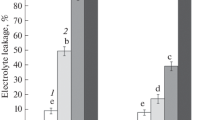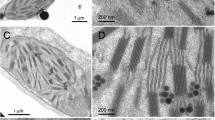Summary
The ultrastructure of chloroplasts from radish seedlings (Raphanus sativus L.) grown at high (24 klux; 250 W · m−2) and at low-light quanta fluence rates (1 klux; 15W · m−2) exhibits differences in many structural parameters.
-
1.
The low-light (shade-type) chloroplasts are characterized not only by higher grana stacks and a higher stacking degree of thylakoids, but also by broader grana than the high-light (sun-type) chloroplasts. The latter are larger (length and width), possess large starch grains and contain more and larger plastoglobuli than the shade-type chloroplasts of the low-light plants, which are lacking starch.
-
2.
The photosynthesis herbicide bentazon (10−4M) induces a shade-type adaptation (broader and higher grana stacks, higher stacking degree) particularly at high and to some extent also at low-light quanta fluence rates. The starch content and the number of plastoglobuli in the high-light bentazon chloroplasts is reduced as compared to the high-light controls.
Similar content being viewed by others
Abbreviations
- HL chloroplast:
-
chloroplast from the leaf of a high-light plant
- LL chloroplast:
-
chloroplast from the leaf of a low-light plant
- HL plant:
-
high-light plant grown at high-light quanta fluence rates
- LL plant:
-
low-light plant grown at low-light quanta fluence rates
- klux:
-
kilolux
References
Abel, B., 1956: Über die Beeinflussung der Chloroplastenstruktur durch Licht beiAntirrhinum majus (haploid). Naturwissenschaften43, 136–137.
Anderson, J. M., Goodchild, D. J., Boardman, N. K., 1973: Composition of the photosystems and chloroplast structure in extreme shade plants. Biochim. biophys. Acta325, 573–585.
Ballantine, J. E. M., Forde, B. J., 1970: The effect of light intensity and temperature on plant growth and chloroplast ultrastructure in soybean. Amer. J. Bot.57, 1150–1159.
Boardman, N. K., Björkman, O., Anderson, J. M., Goodchild, D. J., Thorne, S. W., 1975: Photosynthetic adaptation of higher plants to light intensity: relationship between chloroplast structure, composition of the photosystems and photosynthetic rates. In: Proc. 3rd Int. Congr. on Photosynthesis, Vol. III, pp. 1809–1827 (Avron, M., ed.). Amsterdam: Elsevier.
Buschmann, C., Meier, D., Kleudgen, H. K., Lichtenthaler, H. K., 1978: Regulation of chloroplast development by red and blue light. Photochem. Photobiol.27, 195–198.
Fasse-Franzisket, U., 1956: Die Teilung der Proplastiden und Chloroplasten beiAgapanthus umbellatus l'Herit. Protoplasma45, 194–227.
Fedtke, C., Deichgräber, G., Schnepf, E., 1977: Herbicide induced changes in wheat chloroplast ultrastructure and chlorophyll a/b ratio. Biochem. Physiol. Pflanz.171, 307–312.
Grahl, H., Wild, A., 1973: Lichtinduzierte Veränderungen im Photosynthese-Apparat vonSinapis alba. Ber. dtsch. bot. Ges.86, 341–349.
Guillot-Salomon, T., Tuquet, C., Lubac, M. de, Hallais, M.-F., Signol, M., 1978: Analyse comparative de l'ultrastructure et de la composition lipidique des chloroplastes de plantes d'ombre et de soleil. Cytobiol.17, 442–452.
Klein, S., Neuman, J., 1966: The greening of etiolated bean leaves and the development of chloroplast fine structure in absence of photosynthesis. Plant Cell. Physiol.7, 115–123.
Lichtenthaler, H. K., 1969: Die Plastoglobuli von Spinat, ihre Größe und Zusammensetzung während der Chloroplastendegeneration. Protoplasma68, 315–326.
—,Weinert, H., 1970: Die Beziehungen zwischen Lipochinonsynthese und Plastoglobulibildung in den Chloroplasten vonFicus elastica Roxb. 2. Naturforsch.25 b, 619–623.
—,Buschmann, C., 1978: Control of chloroplast development by red light, blue light and phytohormones. In: Chloroplast development: developments in plant biology, Vol. II, pp. 801–816 (Akoyunoglou, G.,et al., eds.). Amsterdam: Elsevier.
—, 1979: Effect of biocides on the development of the photosynthetic apparatus of radish seedlings grown under strong and weak light conditions. Z. Naturforsch.34 c, 936–940.
—, 1980: Prenylquinones in plant leaves. In: Advances in the biogenesis and function of plant lipids, pp. 299–310 (Mazliak, P.,et al., eds.). Amsterdam: Elsevier.
- 1981: Adaptation of leaves and chloroplasts to high quanta fluence rates. In: Proceed. 5th Internat. Congress on Photosynthesis (Akoyunoglou, G.,et al., eds.). In press.
-Buschmann, C.,Döll, M.,Fietz, H.-J.,Bach, T.,Kozel, U.,Meier, D.,Rahmsdorf, U., 1981: Photosynthetic activity, chloroplast ultrastructure, and leaf characteristics of high-light and low-light plants and of sun and shade leaves. Photosynth. Res. (accepted).
- -Hamm, R.,Retzlaff, G., 1981: Uptake and physiological effects of bentazon in radish seedlings grown at high- and low-light quanta fluence rates. Z. Naturforsch. (in preparation).
Meier, D., Lichtenthaler, H. K., Burkard, G., 1980: Change of chloroplast ultrastructure in radish seedlings under the influence of the photosystem II-herbicide bentazon. Z. Naturforsch.35 c, 656–664.
Palade, G. E., 1952: A study of fixation for electron microscopy. J. exp. Med.95, 285–297.
Pfister, K., Buschmann, C., Lichtenthaler, H. K., 1974: Inhibition of the photosynthetic electron transport by bentazon; Proceedings of the 3rd International Congress on Photosynthesis, Weizmann Institute of Science, Rehovot, Israel. Vol. I, pp. 675–681 (Avron, M., ed.). Amsterdam: Elsevier.
Reynolds, E. S., 1963: The use of lead citrate at high pH as an electron opaque stain in electron microscopy. J. Cell. Biol.17, 208–212.
Skene, D. S., 1974: Chloroplast structure in mature apple leaves grown under different levels of illumination and their response to changed illumination. Proc. Roy. Soc. Lond.186, 75–78.
Spurr, A. R., 1969: A low-viscosity epoxy resin embedding medium for electron microscopy. J. Ultrastruct. Res.26, 31–43.
Verbeek, L., Lichtenthaler, H. K., 1973: Der Einfluß von Stickstoffmangel auf die Lipochinon- und Isoprenoidsynthese der Chloroplasten vonHordeum vulgare L. Z. Pflanzenphysiol.70, 245–258.
Wergin, W. R., Potter, J. R., 1975: The effects of fluometuron on the ultrastructural development, chlorophyll accumulation and photosynthetic competence in developing velvet-leaf seedlings. Pest. Biochem. Physiol.5, 265–279.
Wild, A., 1979: Physiology of photosynthesis in higher plants. The adaptation of photosynthesis to light intensity and light quality in higher plants. Ber. dtsch. bot. Ges.92, 341–364.
Author information
Authors and Affiliations
Rights and permissions
About this article
Cite this article
Meier, D., Lichtenthaler, H.K. Ultrastructural development of chloroplasts in radish seedlings grown at high- and low-light conditions and in the presence of the herbicide bentazon. Protoplasma 107, 195–207 (1981). https://doi.org/10.1007/BF01275618
Received:
Accepted:
Issue Date:
DOI: https://doi.org/10.1007/BF01275618




